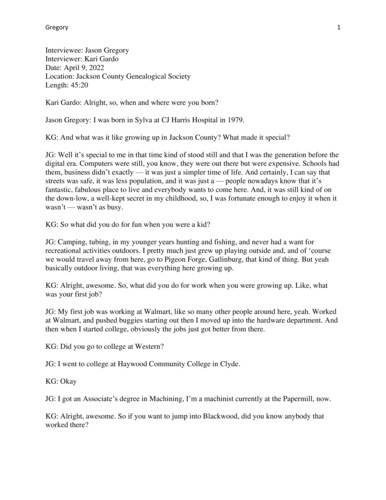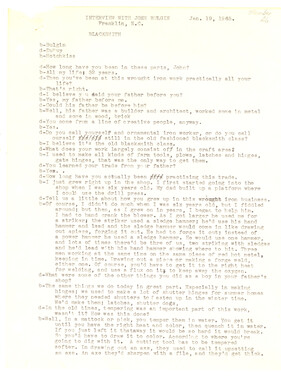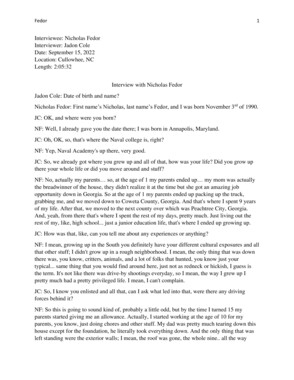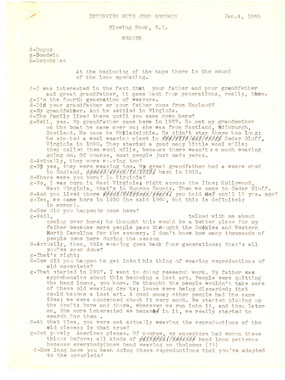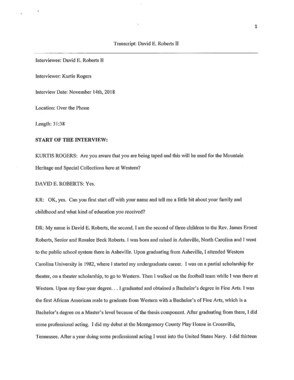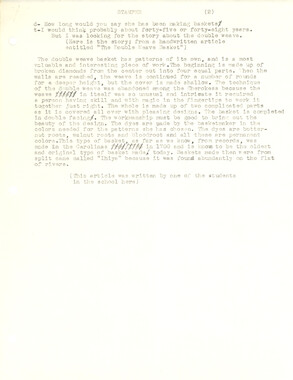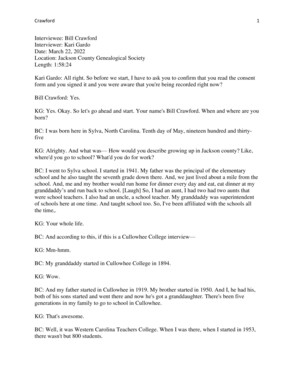Western Carolina University (20)
View all
- Canton Champion Fibre Company (2308)
- Cherokee Traditions (293)
- Civil War in Southern Appalachia (165)
- Craft Revival (1942)
- Great Smoky Mountains - A Park for America (2767)
- Highlights from Western Carolina University (430)
- Horace Kephart (941)
- Journeys Through Jackson (154)
- LGBTQIA+ Archive of Jackson County (26)
- Oral Histories of Western North Carolina (314)
- Picturing Appalachia (6772)
- Stories of Mountain Folk (413)
- Travel Western North Carolina (160)
- Western Carolina University Fine Art Museum Vitreograph Collection (129)
- Western Carolina University Herbarium (92)
- Western Carolina University: Making Memories (708)
- Western Carolina University Publications (2283)
- Western Carolina University Restricted Electronic Theses and Dissertations (146)
- Western North Carolina Regional Maps (71)
- World War II in Southern Appalachia (131)
University of North Carolina Asheville (6)
View all
- Allanstand Cottage Industries (62)
- Appalachian National Park Association (53)
- Bennett, Kelly, 1890-1974 (1388)
- Berry, Walter (76)
- Brasstown Carvers (40)
- Carver, George Washington, 1864?-1943 (26)
- Cathey, Joseph, 1803-1874 (1)
- Champion Fibre Company (233)
- Champion Paper and Fibre Company (297)
- Cherokee Indian Fair Association (16)
- Cherokee Language Program (22)
- Crowe, Amanda (40)
- Edmonston, Thomas Benton, 1842-1907 (7)
- Ensley, A. L. (Abraham Lincoln), 1865-1948 (275)
- Fromer, Irving Rhodes, 1913-1994 (70)
- George Butz (BFS 1907) (46)
- Goodrich, Frances Louisa (120)
- Grant, George Alexander, 1891-1964 (96)
- Heard, Marian Gladys (60)
- Kephart, Calvin, 1883-1969 (15)
- Kephart, Horace, 1862-1931 (313)
- Kephart, Laura, 1862-1954 (39)
- Laney, Gideon Thomas, 1889-1976 (439)
- Masa, George, 1881-1933 (61)
- McElhinney, William Julian, 1896-1953 (44)
- Niggli, Josephina, 1910-1983 (10)
- North Carolina Park Commission (105)
- Osborne, Kezia Stradley (9)
- Owens, Samuel Robert, 1918-1995 (11)
- Penland Weavers and Potters (36)
- Roberts, Vivienne (15)
- Roth, Albert, 1890-1974 (142)
- Schenck, Carl Alwin, 1868-1955 (1)
- Sherrill's Photography Studio (2565)
- Southern Highland Handicraft Guild (127)
- Southern Highlanders, Inc. (71)
- Stalcup, Jesse Bryson (46)
- Stearns, I. K. (213)
- Thompson, James Edward, 1880-1976 (226)
- United States. Indian Arts and Crafts Board (130)
- USFS (683)
- Vance, Zebulon Baird, 1830-1894 (1)
- Weaver, Zebulon, 1872-1948 (58)
- Western Carolina College (230)
- Western Carolina Teachers College (282)
- Western Carolina University (1794)
- Western Carolina University. Mountain Heritage Center (18)
- Whitman, Walt, 1819-1892 (10)
- Wilburn, Hiram Coleman, 1880-1967 (73)
- Williams, Isadora (3)
- Cain, Doreyl Ammons (0)
- Crittenden, Lorraine (0)
- Rhodes, Judy (0)
- Smith, Edward Clark (0)
- Appalachian Region, Southern (2399)
- Asheville (N.C.) (1917)
- Avery County (N.C.) (26)
- Blount County (Tenn.) (161)
- Buncombe County (N.C.) (1671)
- Cherokee County (N.C.) (283)
- Clay County (N.C.) (555)
- Graham County (N.C.) (233)
- Great Smoky Mountains National Park (N.C. and Tenn.) (510)
- Haywood County (N.C.) (3522)
- Henderson County (N.C.) (70)
- Jackson County (N.C.) (4692)
- Knox County (Tenn.) (25)
- Knoxville (Tenn.) (12)
- Lake Santeetlah (N.C.) (10)
- Macon County (N.C.) (420)
- Madison County (N.C.) (211)
- McDowell County (N.C.) (39)
- Mitchell County (N.C.) (132)
- Polk County (N.C.) (35)
- Qualla Boundary (981)
- Rutherford County (N.C.) (76)
- Swain County (N.C.) (2113)
- Transylvania County (N.C.) (247)
- Watauga County (N.C.) (12)
- Waynesville (N.C.) (73)
- Yancey County (N.C.) (72)
- Aerial Photographs (3)
- Aerial Views (60)
- Albums (books) (4)
- Articles (1)
- Artifacts (object Genre) (228)
- Bibliographies (1)
- Biography (general Genre) (2)
- Cards (information Artifacts) (38)
- Clippings (information Artifacts) (191)
- Crafts (art Genres) (622)
- Depictions (visual Works) (21)
- Design Drawings (1)
- Drawings (visual Works) (184)
- Envelopes (73)
- Facsimiles (reproductions) (1)
- Fiction (general Genre) (4)
- Financial Records (12)
- Fliers (printed Matter) (67)
- Glass Plate Negatives (381)
- Guidebooks (2)
- Internegatives (10)
- Interviews (812)
- Land Surveys (102)
- Letters (correspondence) (1013)
- Manuscripts (documents) (619)
- Maps (documents) (177)
- Memorandums (25)
- Minutes (administrative Records) (59)
- Negatives (photographs) (5835)
- Newsletters (1285)
- Newspapers (2)
- Occupation Currency (1)
- Paintings (visual Works) (1)
- Pen And Ink Drawings (1)
- Periodicals (193)
- Personal Narratives (10)
- Photographs (12976)
- Plans (maps) (1)
- Poetry (7)
- Portraits (1960)
- Postcards (329)
- Programs (documents) (151)
- Publications (documents) (2237)
- Questionnaires (65)
- Scrapbooks (282)
- Sheet Music (2)
- Slides (photographs) (402)
- Songs (musical Compositions) (2)
- Sound Recordings (796)
- Specimens (92)
- Speeches (documents) (15)
- Tintypes (photographs) (8)
- Transcripts (322)
- Video Recordings (physical Artifacts) (23)
- Vitreographs (129)
- Text Messages (0)
- A.L. Ensley Collection (275)
- Appalachian Industrial School Records (7)
- Appalachian National Park Association Records (336)
- Axley-Meroney Collection (2)
- Bayard Wootten Photograph Collection (20)
- Bethel Rural Community Organization Collection (7)
- Blumer Collection (5)
- C.W. Slagle Collection (20)
- Canton Area Historical Museum (2110)
- Carlos C. Campbell Collection (282)
- Cataloochee History Project (65)
- Cherokee Studies Collection (4)
- Daisy Dame Photograph Album (5)
- Daniel Boone VI Collection (1)
- Doris Ulmann Photograph Collection (112)
- Elizabeth H. Lasley Collection (1)
- Elizabeth Woolworth Szold Fleharty Collection (4)
- Frank Fry Collection (95)
- George Masa Collection (173)
- Gideon Laney Collection (452)
- Hazel Scarborough Collection (2)
- Hiram C. Wilburn Papers (28)
- Historic Photographs Collection (236)
- Horace Kephart Collection (861)
- Humbard Collection (33)
- Hunter and Weaver Families Collection (1)
- I. D. Blumenthal Collection (4)
- Isadora Williams Collection (4)
- Jesse Bryson Stalcup Collection (47)
- Jim Thompson Collection (224)
- John B. Battle Collection (7)
- John C. Campbell Folk School Records (80)
- John Parris Collection (6)
- Judaculla Rock project (2)
- Kelly Bennett Collection (1407)
- Love Family Papers (11)
- Major Wiley Parris Civil War Letters (3)
- Map Collection (12)
- McFee-Misemer Civil War Letters (34)
- Mountain Heritage Center Collection (4)
- Norburn - Robertson - Thomson Families Collection (44)
- Pauline Hood Collection (7)
- Pre-Guild Collection (2)
- Qualla Arts and Crafts Mutual Collection (12)
- R.A. Romanes Collection (681)
- Rosser H. Taylor Collection (1)
- Samuel Robert Owens Collection (94)
- Sara Madison Collection (144)
- Sherrill Studio Photo Collection (2558)
- Smoky Mountains Hiking Club Collection (616)
- Stories of Mountain Folk - Radio Programs (374)
- The Reporter, Western Carolina University (510)
- Venoy and Elizabeth Reed Collection (16)
- WCU Gender and Sexuality Oral History Project (32)
- WCU Mountain Heritage Center Oral Histories (25)
- WCU Oral History Collection - Mountain People, Mountain Lives (71)
- WCU Students Newspapers Collection (1744)
- Western North Carolina Tomorrow Black Oral History Project (69)
- William Williams Stringfield Collection (2)
- Zebulon Weaver Collection (109)
- African Americans (390)
- Appalachian Trail (35)
- Artisans (521)
- Cherokee art (84)
- Cherokee artists -- North Carolina (10)
- Cherokee language (21)
- Cherokee pottery (101)
- Cherokee women (208)
- Church buildings (167)
- Civilian Conservation Corps (U.S.) (110)
- College student newspapers and periodicals (1830)
- Dams (103)
- Dance (1023)
- Education (222)
- Floods (61)
- Folk music (1015)
- Forced removal, 1813-1903 (2)
- Forest conservation (220)
- Forests and forestry (1058)
- Gender nonconformity (4)
- Great Smoky Mountains National Park (N.C. and Tenn.) (181)
- Hunting (38)
- Landscape photography (10)
- Logging (103)
- Maps (84)
- Mines and mineral resources (8)
- North Carolina -- Maps (18)
- Paper industry (38)
- Postcards (255)
- Pottery (135)
- Railroad trains (71)
- Rural electrification -- North Carolina, Western (3)
- School integration -- Southern States (2)
- Segregation -- North Carolina, Western (5)
- Slavery (5)
- Sports (452)
- Storytelling (245)
- Waterfalls -- Great Smoky Mountains (N.C. and Tenn.) (66)
- Weaving -- Appalachian Region, Southern (280)
- Wood-carving -- Appalachian Region, Southern (328)
- World War, 1939-1945 (173)
Interview with Jason Gregory, transcript
Item
Item’s are ‘child’ level descriptions to ‘parent’ objects, (e.g. one page of a whole book).
-
-
Gregory 1 Interviewee: Jason Gregory Interviewer: Kari Gardo Date: April 9, 2022 Location: Jackson County Genealogical Society Length: 45:20 Kari Gardo: Alright, so, when and where were you born? Jason Gregory: I was born in Sylva at CJ Harris Hospital in 1979. KG: And what was it like growing up in Jackson County? What made it special? JG: Well it’s special to me in that time kind of stood still and that I was the generation before the digital era. Computers were still, you know, they were out there but were expensive. Schools had them, business didn’t exactly — it was just a simpler time of life. And certainly, I can say that streets was safe, it was less population, and it was just a — people nowadays know that it’s fantastic, fabulous place to live and everybody wants to come here. And, it was still kind of on the down-low, a well-kept secret in my childhood, so, I was fortunate enough to enjoy it when it wasn’t — wasn’t as busy. KG: So what did you do for fun when you were a kid? JG: Camping, tubing, in my younger years hunting and fishing, and never had a want for recreational activities outdoors. I pretty much just grew up playing outside and, and of ‘course we would travel away from here, go to Pigeon Forge, Gatlinburg, that kind of thing. But yeah basically outdoor living, that was everything here growing up. KG: Alright, awesome. So, what did you do for work when you were growing up. Like, what was your first job? JG: My first job was working at Walmart, like so many other people around here, yeah. Worked at Walmart, and pushed buggies starting out then I moved up into the hardware department. And then when I started college, obviously the jobs just got better from there. KG: Did you go to college at Western? JG: I went to college at Haywood Community College in Clyde. KG: Okay JG: I got an Associate’s degree in Machining, I’m a machinist currently at the Papermill, now. KG: Alright, awesome. So if you want to jump into Blackwood, did you know anybody that worked there? Gregory 2 JG: I’m trying to think about that. I’m sure that I crossed paths with someone. My wife had a great-uncle that worked there, and when the Great Depression hit he went out to the state of Washington, like so many families from Jackson County migrated for work in the timber industry. KG: Did you ever talk to her about it? JG: I did, I actually have some of his records that got passed down through the family that are going to be in an upcoming book that I’m doing on a similar related work. But some of the records are pay-tickets, and it gives good insight into how they were paid. They’d make twenty-five, twenty-eight cents per hour, and that was dang good money in those days. KG: Yeah. So, I mean, what do you imagine it was like working there? JG: It was hard work. People weren’t scared to get dirty and hard work, I’ll say that again. There wasn’t safety programs in place like there is now throughout the United States. ‘Course when these people worked, if someone died or got hurt they sent condolences to the family, but there was somebody ready to fill your spot oftentimes and that’s just the sad reality of it. Logging, and tree-cutting, and timber related work is to this day, and has always remained, a very dangerous trade. But, its safer now than it’s ever been. KG: When you said dangerous it made me think of those [referring to image]. JG: Well, people wore no, safety glasses didn’t exist before the 1950’s. That just wasn’t a commonplace item. But, those are not hard hats in those pictures. Those are just leather-brim hats. And safety was just an afterthought in this country, after decade and decade worth of injury. KG: Mh-hmm. And, in terms of how Blackwood affected the county by coming in, like, what were some of the benefits of Blackwood coming into Jackson County? JG: Well if I may refer to my notes. KG: Yeah. JG: The thing about Blackwood Lumber Company, if you do a Google search today, and you typed in “Blackwood Lumber Company,” you’re limited to Sylva Herald articles, historic pictures that’s at Western Carolina University’s digital collection, and most people get the gist that it was that it was a saw mill. But, it actually is part of an interlinked and a deeper history of Jackson County, and I’d like to just touch base on a little bit of that to answer your question. Blackwood was indeed, out of the sixty some companies that came to Jackson County, and they were northern-based companies, like in Maine, and often brought their own employers, employees, excuse me. They didn’t hire locally. Their techniques, I’ll discuss one here in just a minute, their techniques involved techniques used, like, in Maine. It didn’t work in these mountains. An example of that is the Blue Ridge Lumber Company. It was the first large scale logging operation in Jackson County and their failure was that they tried to float logs down the Tuckasegee River, and that just really was counterproductive. That worked in the large, wide Gregory 3 rivers up north. They often got jammed up and it escalated to the point that a foreman drowned trying to clear a log jam, a key person to the management of Blackwood Lumber Company [Meant Blue Ridge Lumber Company]. In the 1890’s there was a mill-pond in Dillsboro and the mill-pond dam broke loose, and it sent logs way down the Tuckasegee River, maybe into Tennessee, other states, or other areas. It caused several million dollars worth of destruction. So, obviously, in the 1890’s, they folded up shop and left. But, I want to point out that, that’s not considered the earliest industry in this county, historically, because they didn’t employ local people and that was a great source of tension for Jackson County. I’m going to talk just a second about the earliest industry in the county. The earliest large-scale industry was the CJ Harris Tannery, which the remains of that business, it closed in 1957, are located at Jackson Paper Manufacturing Company here in Sylva, the current Papermill that used to be Mead. We still have the old tannery buildings. But why all of that is important and relative to Blackwood is that before, prior to 1902, when the tannery was established, the farmer’s greatest tax liability, or greatest liability, was the ability to pay their yearly land taxes to save their farms. A catastrophic event in farming, or a death in the family and there were no hands to sell livestock, or, they had to do something to save money. And in those days prior to 1902, nobody had any really hard cash. And I’d like to point out that bartering, was a huge, huge source of payment in Jackson County, and it’s well documented into the 1960’s at some of these local stores. People would barter for goods with like, my great-grandfather, he would split locust stakes, and he had an account at Bradley store in Dillsboro. He had a credit account, and he would pay part of that account by barter. So where I’m going at with that, is that, let’s see, we were talking about bartering. It’s that nobody had any real hard cash, as I said, and the tannery was the first business to change all that. What the tannery brought to Jackson County was, there’s a season on bark, the collecting of chestnut bark, and it was around mid-April to June, you know, that was roughly the season. Bark contained tannic acid and they would boil it to get the acid out to tan leather at the tannery. So, for the first time in the history of Jackson County, there was a beginning of a reliable, yearly, source of income. They would collect tan-bark, that one season, and they didn’t have to panic about how they were going to raise the taxes to save their farms. A lot of people would lose their farms that they had had for many generations. It would just happen a bad year and it was gone, they couldn’t pay their taxes. So, that is extremely important. The second thing that I’m going to mention, is that, so what the tannery did was that they would run the bark through a shredder and that would grind it into pellets. They would boil and get the tannic acid out of the chipped bark, and then they would, in 1902, they would boil, they would just burn the pellets in the boiler. But, in interviewing people for my other upcoming work, I’ve discovered that there were hundreds of thousands of these pellets everywhere, and they come up with a way, well, let me just back up. In 1915, CJ Harris sold the tannery to Armour Leather Company, and Armour Leather Company was a division of Armour Products, the food company that still exists today. They had the financial backing, they installed a chipper, one of four major overhauls, four main new buildings, the extract plant and the chipper, in 1916. There’s a reason that this is important to the subject of Blackwood and I’m going to get to that in just a moment, but I just want to tell you that it is relevant. In 1916, they added a chipper, and the tannery owned this chipper at that time. They sold it in ’28 to the Papermill. But, prior to that time, they owned it from 1916, to 1928. An additional product was available to families and it was called tannic acid-wood, or people here today call it cord-wood. Basically, it is the chestnut wood, they had to cut it in five-foot lengths, and they could handle five-inch diameter to twenty inches in diameter. Gregory 4 So, now you had two products that people in Jackson County could make money off of. You had the seasonal tan bark and then, year-round, you had this chestnut acid-wood. The reason that’s relative to Blackwood is that was nearly a 40,000 acre tract, and they sold permits so people from the community was able to get a permit and they got those resources off the Blackwood tract. Blackwood bought those resources as a middle-man. You had the ability to haul it to the Sylva Tanning Company and later it was the Sylva Paperboard Company before it was Mead, and let’s just say the Papermill for a simpler phrase. But the reason that place offered a convenient service to the public is it wasn’t until the late 1940’s and mid 1950’s that an automobile, much less alone a truck, a pick-up truck or a tow-truck, was available for farmers and local residents. So, what that meant was they traveled on horse-back, largely, until the 1940’s, or walked. They hauled the tan-bark and they hauled them cord-wood. It took a lot longer, it was slower, it wasn’t as productive. If they got full-price for these goods they had to haul it all over Jackson County in a wagon. But what my research indicates is that Blackwood, their store at the mill town in East LaPorte, they actually bought it at a reduced price than they could get here because they were doing the work. They actually had a rail-line in place since 1922, and they, you would get just a little bit less for it than what you could get if you took it to these places in Sylva yourself. So, all people had to do was haul it to the yard at East LaPorte or to the mouth of Moses Creek, and some of the tributaries up at Little Canada or Caney Fork, where they had their fifteen miles of rail-line. It was a convenience, all they had to do was just to drop it off at the side of the line and just arrange a pick-up. So it brought value too, very few people know that unless you’ve done research, like I have discovered. But, it’s not just about the lumber, it’s about all these other side-surfaces that people made a living off of. KG: I mean, would you say that the railroad helped? JG: Well, it certainly helped, and I’ll touch base on that for just a second because this affected everyone in Jackson County. KG: Yeah. JG: They were chartered in July. Blackwood Lumber Company was chartered in July of 1920. And in their Deed of Trust, to the bank in Philadelphia, they were required to build a rail-line from the main line in Sylva all the way to a site in Tuckasegee. At the time of the Deed of Trust they didn’t know where the site was, but they had to have the rail line in place and the mill town and saw-mill built with the capacity for a minimum of fifteen-thousand, no, excuse me, fifteen-million board feet of lumber a year is what that saw-mill had to produce. And saw-mill, so once that was in place, they actually operated under a subsidiary name, the TS&E, or the Tuckasegee Southeastern Railway Company. That job was to manage the, well, you had the Blackwood management of the mill town and the saw-mill at East LaPorte, but it largely oversaw the rail-lines from Sylva to East LaPorte. They, let me just refer to my notes just a second, lets see. KG: Yeah. JG: Yeah, so, the rail-line started in 1922, and what made this really valuable was that they had passenger service, starting in 1922, that made four stops a day. They stopped at Sylva at the Sylva Depot, which is just inside of here on the back street. They made stops at Sylva, Dicks Gregory 5 Gap, which is basically where the rock-cut is near the entrance of Western Carolina University. There’s a sign that says “Dicks Gap” you can see it when you’re on 107 going that way. They stopped at Cullowhee, Webster, and, of course, they ended at the mill town at East LaPorte. In 1921, a second subsidiary was formed with a different purpose. The Caney Fork Logging and Railway Company was incorporated for the specific task of running rail-lines from East LaPorte up to Caney Fork and across the end of Caney Fork at Sugar Creek Gap into the Canada section. That was about fifteen miles of rail-line they were responsible for putting up. They also coordinated, they established a store in both Little Canada and in the upper-end of Caney Fork. So they managed that. As far as offering value to the public, you didn’t have to, the employees got a special price. You could ride, well, it was a huge, huge deal in a time where no one had an automobile to be able to hop on a train for a fraction of the cost that you could, like, a large-scale southern railway ticket. You could ride to Sylva to do business and come back, you could. It was a huge deal. It gave a great amount of transportation to an area that wasn’t slated to get transportation, good transportation ‘til the 1950’s. The students at the Cullowhee Normal School, which was a forerunner for Western Carolina University, now they used this service to get back and forth to school. Basically, Blackwood Lumber Company’s passenger train service allowed a great amount of transportation that normally would’ve taken all day to do by horse or wagon. So, it’s a really big deal what it offered the community. KG: Speaking of transportation, that would bring me to logging in this type of country. The terrain was so difficult to work with. I mean, Bill [Crawford] was talking about, when I spoke to him about the oxen pulling these logs that they had this mechanism to steer ‘em one way and the logs would just go down the hill because they were just so massive and heavy. JG: There is a thing, this is an Appalachian term in it’s entirety, but I’m sure he’s talking about grabs. KG: Yeah JG: And grabs are just a pair of hooks that are bound like handcuffs in the middle with a chain, and it was just a sharpened end and they would drive, with a go-devil, the end into the log, and the other end they had it hooked to the oxen line in this photograph. There were certain maneuvers they could do, like put it in a J-hold, or they could release it just be pulling the reigns, pulling it a certain way. If it’s going to go over the bank and they can’t stop it, there was a way to quickly release it. It was as much a means to transport as much as it was a means for safety. KG: Do you think, like, I guess these pictures are what I’m going for, like how massive these trees were. I mean, were they valuable enough to like, want, is it the type of tree? JG: Here’s the whole root of this. KG: Okay. JG: The whole root of this is this. You know I mentioned earlier that there was about sixty companies, northern companies, that came to this area to log. They all failed in the end because of one common problem, they didn’t have the rail-lines and the trestles in place to get the timber Gregory 6 out. Blackwood Lumber Company were the first people to get those out. The reason they were so valuable is that these were virgin timber forests. These are logs that had stood hundreds of years before the lands were seceded to the Cherokee Indians by the Robert Love Survey of 1820 where the government, where the land was taken from the Cherokee’s and white settlers were able to come further west. So, they were several hundred years old then. What we have now, when you look around outside, what you see now is what’s called second-growth. And, this second growth, it would take several hundred years. I, you, none of us will ever see timbers three, four foot around in our lifetime grow from scratch. It was here since several hundred years. So, to answer your question, extremely valuable timbers, but it was a race to who had the technology to get it out. And Blackwood Lumber Company won, but they didn’t have in place a forestry management program. They exploited the natural resources in about ten to sixteen years and about the same time that the Great Depression hit. So, to answer your question, they got to it first, but they didn’t have a management, like, laying off this track ‘til it gets a certain, or, replanting. They didn’t have replanting or replenishment practices in place, so they took everything. KG: That brings me to this, so I guess when everything was gone or for the most part cleared out like in this photo here. How, especially during the depression, how did that affect the resources for the community? Like wildlife, or? JG: I’m sorry, tell me your question again, I apologize. KG: Okay, so, I’ll rephrase. When they cleared out all of this land, especially. JG: When the resources were gone. KG: When the resources were gone, especially during the Depression, like, how did that affect the natural resources for the county, the people? I’m sure this isn’t a suitable environment for wildlife. JG: Well, there wasn’t environmental controls in the United States government at that time. The government just started to form national parks in the ‘30’s and ‘40’s and they passed legislation because of these exploitative practices of these companies, corporate greed so to speak in some instances. It made them pass certain legislation. We will never see the devastation today because of the laws in place. There are photos of all of these mountains here in the ‘20’s and ‘30’s and they were just big balds. You wouldn’t see timber like this, you would just see, you would in the highest parts of the mountains, but you would just see all of these big balds, pasture lands where people had just stripped the timber because it was a way of making money. KG: And, in terms of money and Blackwood. They started out selling flooring, right? So how did that move into, did they keep doing flooring, or? JG: Flooring, as I understand, was their bread and butter, their main product. They did move into some mill work towards the peak of that. But a key fact happened that caused the failure of Blackwood Lumber Company. The president died and I can’t think of his name off-hand, I think it’s Joseph Walker Keys, but I cannot think of the name off-hand. But this president died, and it Gregory 7 was left to his wife to contend. You know, she didn’t know how to manage a company, so in 1935 they disbanded the Caney Fork Logging and Railway Company which was the ones that oversaw the trains, the stores, and the rail-lines, fifteen miles of rail-lines up Canada, Caney Fork to Canada. Then 1940 it was pretty much shut down to the point where they’re starting to scrap the whole mill, and something unfortunate happened. In 1945, I believe it was, part of the dismantling process, they had sold it to a scrap yard in Virginia, I believe it was Virginia, an acetylene cutting torch used to cut steel to dismantle the saw mill caught fire all structures caught fire and it burned. So any hopes of any hopes of salvage in any of the Milltown buildings or pretty much the sawmill burnt if I understand it correctly the sawmill burn up and that was just really was the final nail in the coffin and then and then it got sold to the Mead Corporation in 1945. KG: Would you say that economically was Mead more, what’s the word? JG: Stable or better management. KG: Was Mead more efficient in managing like here they didn’t have as many regulations. JG: They certainly were, I know what you’re about to ask. They had a they actually had a Blackwood track maintenance management. KG: Okay JG: And I’ve got a copy of that from 19… every decade they had to do an annual budget and forecast the types of timber that would be on the track but they had a stellar, stellar incredible forestry management program which was unheard of at that time in the United States, but they had top forestry people involved and they would lay off certain tracks for seven years to harvest timber and I replenished the land by planting trees and they had a land use program to where people can turn off the game lands and fish in and it still continued to be recreational use. And going back to what we were talking about, I don’t know that I told you this, but in addition to selling permits that families could get the tannic acid wood and get the tan bark off the Blackwood track. They also allowed people by permit to free range cattle up there. So they’d pay a little fee and I don’t know if it was year round, but they would let their livestock free range up there on the Blackwood tract. Different place. KG: So there was further development when they came in, more progress. JG: More progress. So it continued to be, it continue to be… now I don’t know I’m not sure if I’m gonna say this like my grandpa my great grandpa is a prime example. They make their living selling cord wood, or tannic acid wood to Mead, but they didn’t own any land, it was part of the Blackwood track, but Mead probably at that time didn’t issue permit but they charged stumpage. Which basically, if you don’t own the land you have to pay a percentage. If you’re taking resources of somebody else’s land you had to pay a stumpage fee. Best I understand. So that’s what happened with my great grandparents on the Gregory side of the family. They didn’t own the land, but they paid a stumpage fee to its property owner. Gregory 8 KG: And with the end of Blackwood comes the flood. Did you still want to talk about the flood? JG: Sure let me just real quick, see if there was anything else real important that I needed to touch base on. We talked about the transportation value, Blackwood offered passenger service. We talked about that. We talked about the value of people could save their farms by paying taxes from selling tan bark and acid wood. WE talked about that. We talked about the value of being the middleman buying those products and taking it directly by rail car to the Tannery and the Mill. Let’s see, so yeah, I think we pretty much touched based on the importance of Blackwood. I will just close the subject on Blackwood by saying that in addition to the things we just talked about it’s a piece of that community’s heritage. People still drive by the site today and they know what happened there. Families are what they are today because they made a living in some way from that place. They may not have worked at the sawmill, it may be that they made a living off of the land that Blackwood owned, but there is a lot of heritage tied to that site. That is just so much more than just a sawmill. It was a Mill town. It was the areas first form of transportation it brought community stores and stores that in an area that people would have to go half a day or longer to reach a store. The Blackwood stores that were a Rich Mountain and up Little Canada there were stores, and that was that brought a great value to the community. People could, all around it just improved people’s lives while it existed and operated. That’s just what I would say about Blackwood. KG: So in regards to the flood, did it affect anyone in your family? JG: It affected a lady. There was a lady named Mami Ensley that was a I don’t know if common law wife is the phrase to use but she lived with someone in my family. That wasn’t a direct relation, but was just a collateral cousin. Her name was Mamie Ensley and my grandmother told me that she moved up here because her house was washed away in the flood. And there are countless people that lost everything they had, that got washed away. There are four people that I know of that drowned in the Little Canada section and I’m not sure of the rest of the county. They said in the newspaper clippings that it cost on average about $2 million in 1940 worth of net property damage. And there was only one bridge left standing at that time that I remembered and I think it’s the one at Governors Island down in Swain County in Bryson city. But I was just horrible. Anybody that had a bottom farm down in the bottom on a creek bank or river bank suffered some form of damage either to their farm. Either their house was washed away or flooded or knocked off the foundation to where it had to be completely rebuilt. Livestock and cattle anything that was needed for every day life if it was in the path of the flooding river it was gone. It was just swept away. And if it didn’t get your house because you was lucky to be high up or something you lost something if you was near the river or your neighbor lost something. I mean it was just, if you look back at the history in Jackson County and look back 1895 is as early as we can go with newspaper clippings for the county the Tuckaseigee Democrat. There are others things that are occasionally mention like the Waynesville Mountaineer that go back. There’s some older newspapers in other counties that sometimes mention things. If you look back in history there have been several great floods from the 1870s and 80s and the sad thing is we’re overdue again. We had one around 2006. I don’t know if that’s the year, but it hit this region hard. There’s pictures, it’s gone now, but we used to have a power house that’s part of an old dam in Dillsboro and it flooded right there. And water was coming out the windows and people in a surrounding town over in Clyde down in that bottom, it all got flooded if they had a Gregory 9 house in that bottom off the Pigeon river. It was just terrible. People lost, but the point is that it’s just not going away it’s due to happen again at some point. One of that scale is coming again we just don’t know when. But at that time, the thing that makes the flood of 1940 being said to be the worst one is because there’s no written record of it. There were ones mentioned from other sources in the 1800s that were severe, but we don’t have, like I said our early accounts come from newspapers and the Tuckaseigee Democrat started in 1895 so the reason it’s the worst one is it’s the worst one in recorded history is what I’m trying to say. There were worse ones, but it’s the one that stands out the most. KG: Make sense. You mentioned $2 million worth of damage? JG: I believe that’s what it said in the newspaper clipping and $2 million would be nothing in today’s money but in that economy, that was a lot of money. KG: Do you have a range of estimate of how long it took to kind of get back to normal? JG: Well, I’m not sure about that, but I imagine that a lot of these folks had the land for several generations. And at that time in history unless you had a very fine home, or a very fancy home, people didn’t borrow money from banks to build. They had farms and land willed down through the generations, so they had the land. And they barter for sawmill lumber, and some might have borrowed money from banks, but it was a matter of starting over. Like you think about it today we have insurance on our home if it flooded or we go through banks to get a mortgage on a home. Those folks didn’t certainly do any of that. They just had the land or bartered for sawmill lumber or worked off the money to buy it. They kind of built as they went like the early settlers did. KG: Do you think the community had a lot to do with the recovery? JG: I do absolutely. I know there were some funds. Obviously, there were some funds here and there from state entities and federal. Probably not as great as there is nowadays, but I would say that the backbone of the community and any type of help from the community was the churches. I’m gonna say the churches, they would have been the ones that would have organized, helping people and reaching out. In those days if a neighbor was sick, another neighbor wasn’t too proud to come help get his fields plowed or something. People in those days looked out for one another so I’m gonna say very much that the recovery was largely due to the community, each other’s neighbor. KG: Is there anything else you want to say about the flood before we move on? JG: I would just say that it’s not only, it’s not only the citizens of Jackson County that suffered, but businesses suffered. There’s historic photographs of one of the Blackwood trains that the trestle got undermined, and the trestle caved in with a train crossing it. Any business such as the tannery on Scotts Creek. There were several businesses on the bottom down here in Dillsboro, [inaudible] factory, there was just several businesses that got affected because the flooding from either Scotts Creek or the Tuckasegee River. If it was near there, it affected it somehow and in a negative way. Gregory 10 KG: All right this is kind of a wrap up question. I was curious, after the timber industry left the area and a lot of people went elsewhere for work, such as Washington, if it was you, would you leave and go somewhere else? Or would you stay in Jackson County? JG: I think that’s relative to how many mouths you have to feed. I think if it was just me, I would probably just do whatever to survive. But if I had, in those days, like my ancestors, my great-great grandfather on the Robinson side, he had a 400-acre farm and several different tracks, he had 10 children. It was common practice to have land and lots of times more than 10 13, 14 children have been known. And I guess another thing that I forgot to mention that I was trying to say, Blackwood, from the Tannery in 1902 to Blackwood gave birth to a new concept in Jackson County. There was an addiction to wage employment. People in the mountains when, I talked about barter, they paid bills with barter, they got the goods with barter, barter was very common practice for goods and services. But wage addiction, wage employment addiction occurred and that was the reason that when the Great Depression hit, people were used to having money for the first time ever. No one had had the cold hard cash and when the Great Depression hit that’s why so many people left here because they got used to having money, and money was available in these big logging operations and the Depression did not hit those areas near as hard and people could make money with skills that they had learned from Blackwood and just survival in general here in the mountains. And so yeah, I would just say that the birth of these industries that we discussed largely got the citizens of Jackson county used to the concept of work for pay instead of barter. KG: So you would stay depending? JG: I’m sorry I didn’t answer that question. KG: You did. JG: I think I would stay, there’s no place in the world like these mountains, and I’m privileged enough to have a job that allows me to stay in it. KG: That’s awesome. Before we finish up is there anything else you’d like to add, talk a little bit about what you were working on? JG: I would just say my friend Bill Crawford And my friend Dr Ann Melton, I’m thrilled to have those people in my life as friends and we do research together and they’ve given me great, sound advice over the years. I’m currently working on a book that should be released this fall on the history of the CJ Harris Tannery and Sylva Paperboard Company which later became Mead and is now Jackson Paper Manufacturing Company. The whole gist of this entire conversation is that the history of the Blackwood track, and Blackwood Lumber Company and timber and the Tannery, people don’t associate this connection, but their histories occur at the same time, and their business activities are all intertwined. They work together quite harmoniously. Like I say, one thing I didn’t discuss, I found records where to fuel the boiler, some of the sawdust from Blackwood. Often times they would buy or use each others by products at times they would buy that and use that in the boilers here. It’s just one of the greatest things is how those businesses Gregory 11 built upon another. The sole purpose of the Blackwood tract was for the lumber, that’s why they were there. But they made several thousands of dollars stripping the other resources, the acid wood and the bark and selling them to the Papermill in the Tannery. So my purpose is just to try to promote how these different industries in Jackson county are essentially, they’re all just intermixed, that’s not the word I’m looking for, they’re connected is what I’m trying to say. They are all related to each other one way or another. KG: That’s awesome, sounds exciting. Thank you so much for talking to me about this. JG: Certainly, we appreciate your effort to keep the stuff going. KG: Thank you.
Object
Object’s are ‘parent’ level descriptions to ‘children’ items, (e.g. a book with pages).
-
Jason Gregory, a lifelong resident of Jackson County, talks about its earliest industries including why so many northern industries came to and then failed in the area. He talks about the history of Blackwood Lumber Company and its positive effects on the families of Jackson County, such as the introductions of rail transportation, stores to small communities, and cash to replace the barter system. He talks about the flood of 1940 and the history of floods in the area.
-
